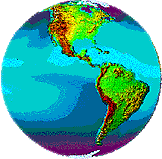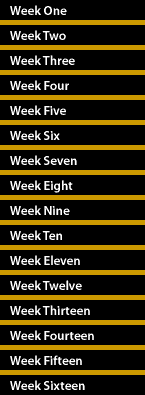 |
 |
 |
 |

Week
11: Water
Weeks
10, 11, and 12 make up a three-week cycle about water. Currently, you
are in Week B: Teacher As Scholar.
This week you should
refer to the resources listed under Readings & References, and you
need to complete the assignments listed under Assignments & Rubrics.
This week’s assignments focus on…
|
Individual:
-
Posting
questions about water, then finding articles and web resources
to build knowledge and background.
-
Helping
teammates to answer their questions.
Team:
|
Readings
& References
Read:
 Can
you imagine being high above the earth and floating free like an astronaut
aboard the Space Shuttle orbiting the planet? Looking out from your craft,
you view this spectacular blue and white sphere called Earth that serves
as home for you and all other life as people know it. It is the only body
in the solar system that appears to support life. Although the earth is
largely rock, most of what you see of the earth's surface is covered by
a relatively thin layer of water (some of it frozen). Can
you imagine being high above the earth and floating free like an astronaut
aboard the Space Shuttle orbiting the planet? Looking out from your craft,
you view this spectacular blue and white sphere called Earth that serves
as home for you and all other life as people know it. It is the only body
in the solar system that appears to support life. Although the earth is
largely rock, most of what you see of the earth's surface is covered by
a relatively thin layer of water (some of it frozen).
Water is an important
natural resource and is an extremely common substance that covers three-fourths
of the earth's surface. It accounts for 60-70% of the weight of the living
world. It is also the physical environment in which many plants and animals
live. Water is something most people take for granted, but it is essential
for life. A person will die much faster from a lack of water than from
a lack of food. Some resources are limited and can be used up, like coal.
Others, like water, are unlimited and are not "likely" to be
used up.
All of this water
may seem to be an endless supply; however, 97% of all the earth's water
is the salt water contained in the oceans. Of the remaining 3% of water,
two-thirds is contained in glaciers and the polar ice caps. The remaining
percentage of all of the earth's water--in ground and surface water combined--that
is available for human consumption is less than 1% of all the water on
the planet. As the world population and pollution increase, the fresh
water quality lowers. Additionally, as the world population increases,
an increase in the demand for fresh water reduces the 1% that is available
for human consumption.
Breakdown of the
Earth's Fresh Water:
| Ice |
77.197% |
| Ground
Water |
22.260% |
| Soil
Moisture |
0.180% |
| Lakes |
0.323% |
| Rivers
& Streams |
0.004% |
| Atmosphere |
0.036% |
|
Total
|
100.00% |
 Read:
Most of the ice on Earth is found near the poles as giant icecaps
in Greenland and Antarctica and as icebergs at sea. Ice is also found
as glaciers and snow in the mountains, and maybe in your neighborhood
in winter. Did you know that when you hold an ice cube in your hand,
you are holding a tiny part of the cryosphere? Read:
Most of the ice on Earth is found near the poles as giant icecaps
in Greenland and Antarctica and as icebergs at sea. Ice is also found
as glaciers and snow in the mountains, and maybe in your neighborhood
in winter. Did you know that when you hold an ice cube in your hand,
you are holding a tiny part of the cryosphere?
The earth's cryosphere
has changed in size many times in the earth's past. Right now, most of
the world's ice is far to the north or south of the planet. But in past
times, even as recently as 12,000 years ago, the earth's climate was much
colder, and huge sheets of ice covered much of North America and Europe
in a great " Ice Age."
Read: On your
own, read about the following topics related to the study of water.
- Water cycle
- Sedimentation
- Biomes wetland
and arctic (Ecosystems/Biomes/Biodiversity)
- How does a plant
use water?
Some related National
Science Education Standards and Project
2061 Benchmarks for Elementary Science Education
- Water can be a
liquid or a solid and can be made to go back and forth from one form
to the other.
- solid, liquid,
or gas (ice-water-air)
- If water is turned
into ice and then the ice is allowed to melt, the amount of water is
the same as it was before freezing.
- Water left in an
open container disappears, but water in a closed container does not
disappear.
- When liquid water
disappears, it turns into a gas (vapor) in the air and can reappear
as a liquid when cooled, or as a solid if cooled below the freezing
point of water.
- Clouds and fog
are made of tiny droplets of water.
- Rain, snow,
rainbows (develop own explanations)
- Wet/dry areas
and seasons (annual rainfall)
- Waves, water, and
ice shape and reshape the earth's land surface by eroding rock and soil
in some areas and depositing them in other areas, sometimes in seasonal
layers.
- Erosion/changes
in the earth (slow and fast)
Recommended Web
Sites:
Assignments
& Rubrics
You will work individually and in teams to address water during
this three-week cycle. Use the links below to access the activities and
rubrics.
Week
B: Teacher As Scholar - Individual
Earth Sphere Scholar Assignment &
Rubric
You will post your questions about Earth system science, find articles
and web resources to build your knowledge and background, post your resources
with annotations to Resource Space, and use what you have learned to answer
your own questions and those of your teammates.
Week
B: Teacher As Scholar - Team
Essential Question Scholar Assignment
& Rubric
You and your teammates will address the essential questions about
water.
- How does water
change?
- How does water
move?
- How does life depend
on water?
- How
does water affect the land?
[
Back
to Outline ]
[
Home ] [ Intro
] [ Guide ] [
Classroom ]
|
 |
 |




|
 |